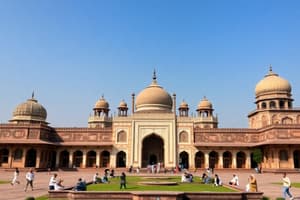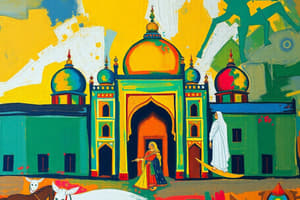Podcast
Questions and Answers
Which of the following dynasties did NOT rule over the Delhi Sultanate?
Which of the following dynasties did NOT rule over the Delhi Sultanate?
- Sayyid Dynasty
- Bahmani Dynasty (correct)
- Lodi Dynasty
- Tughlaq Dynasty
Which of the following rulers attempted to set up a Muslim military, administrative, and cultural elite in the Deccan region during the Delhi Sultanate?
Which of the following rulers attempted to set up a Muslim military, administrative, and cultural elite in the Deccan region during the Delhi Sultanate?
- Qutb al-Din Aibak
- Muhammad ibn Tughluq (correct)
- Shivaji
- Timur (Tamerlane)
Which of the following statements about the Mughal Empire is NOT true?
Which of the following statements about the Mughal Empire is NOT true?
- The Mughals employed administrative practices to suppress and oppress the local population. (correct)
- The Mughals were preceded by the Delhi Sultanate in the Indian subcontinent.
- The Mughals contributed significantly to architecture, including the Taj Mahal.
- The base of the empire's collective wealth was primarily agricultural taxes.
Which of the following empires emerged as a powerful force, challenging the influence of both the Mughals and the Delhi Sultanate?
Which of the following empires emerged as a powerful force, challenging the influence of both the Mughals and the Delhi Sultanate?
Which of the following statements about Indian history is NOT true?
Which of the following statements about Indian history is NOT true?
Which of the following statements about the Mughal Empire is incorrect?
Which of the following statements about the Mughal Empire is incorrect?
Which of the following statements regarding the Mughal Empire's influence on culture is accurate?
Which of the following statements regarding the Mughal Empire's influence on culture is accurate?
Which of the following regions was NOT part of the Mughal Empire's territorial extent at its peak?
Which of the following regions was NOT part of the Mughal Empire's territorial extent at its peak?
Which of the following statements best describes the establishment of the Mughal Empire's rule?
Which of the following statements best describes the establishment of the Mughal Empire's rule?
Which of the following statements is true about the Delhi Sultanate?
Which of the following statements is true about the Delhi Sultanate?
Flashcards are hidden until you start studying
Study Notes
History: Focusing on the Subtopics: Mughal Empire, Delhi Sultanate, Medieval History, and Indian History
Introduction
In the annals of history, the Indian subcontinent has experienced a myriad of empires and dynastic rules, shaping its course and influencing regional politics. Two significant chapters in this history are the Mughal Empire and the Delhi Sultanate. These empires played crucial roles in defining the socio-political landscape of the region during medieval times. In addition to these, we shall delve into broader aspects of Indian history and medieval history.
Mughal Empire (1526-1857)
The Mughal Empire was an early modern empire in South Asia that reached its peak between 1526 and 1707, with Babur as its founder. The empire stretched from the outer fringes of the Indus River Basin to northern Afghanistan and Kashmir in the north, Assam and Bangladesh in the east, and the Deccan Plateau in south India. The Mughals established their rule through military campaigns against local rulers, offering a formidable challenge to existing power structures. This imperial structure is often dated back to Akbar's reign, which lasted until 1720, and it saw significant developments such as centralized administration and standardization of rule.
Mughal Rule and Influence on Culture
Despite being founded by foreign invaders, the Mughal Empire did not vigorously suppress the cultures and peoples it came to rule. Instead, it equalized and placated them through new administrative practices. The base of the empire's collective wealth was agricultural taxes, instituted by Emperor Akbar. The Mughals also contributed significantly to architecture, most notably Taj Mahal, a mausoleum built by Shah Jahan for his wife Mumtaz Mahal.
Delhi Sultanate (1206-1526)
Prior to the Mughal era, the Delhi Sultanate rose to prominence during medieval times, primarily based in Delhi. It spanned from 1206 to 1526 and was ruled by five dynasties: the Mamluk Dynasty (1206-1290), Khalji Dynasty (1290-1320), Tughlaq Dynasty (1320-1414), Sayyid Dynasty (1414-1451), and Lodi Dynasty (1451-1526). During its existence, the Delhi Sultanate covered vast territories encompassing modern-day India, Pakistan, Bangladesh, and Nepal.
Formation and Expansion of Delhi Sultanate
Founded by Qutb al-Din Aibak, the Delhi Sultanate gained momentum under the leadership of Muhammad ibn Tughluq, who attempted to set up a Muslim military, administrative, and cultural elite in the Deccan region. However, the empire faced significant challenges, including invasions by Mongols and Timur (Tamerlane), leading to political instability and fragmentation among lesser principalities. Despite these setbacks, the Delhi Sultanate remained influential, contributing to the development of the Hindustani language and Indo-Islamic architecture.
Medieval History
Medieval times saw a multitude of empires and dynastic rule in the Indian subcontinent, not limited to the Mughal Empire and Delhi Sultanate. Various regional powers and influential figures shaped the course of events during this period. For instance, the Vijayanagara Empire emerged as a powerful force, challenging the influence of both the Mughals and the Delhi Sultanate. Similarly, the Maratha Empire, led by Shivaji, marked another significant chapter in medieval Indian history.
Indian History
Indian history encompasses a vast spectrum of empires, kingdoms, and cultural developments. From the Maurya Empire and Gupta Empire in ancient times to the British colonial rule, each epoch brought about changes that influenced the subcontinent's socio-political landscape. Understanding these historical periods provides valuable insights into India's rich heritage and its journey towards becoming an independent nation.
In conclusion, the study of history offers crucial insights into the past, allowing us to learn from our ancestors' experiences and shape our present and future. By examining the rise and fall of empires like the Mughal Empire and Delhi Sultanate, we can better understand the evolution of the Indian subcontinent in terms of politics, culture, and societal norms.
Studying That Suits You
Use AI to generate personalized quizzes and flashcards to suit your learning preferences.




